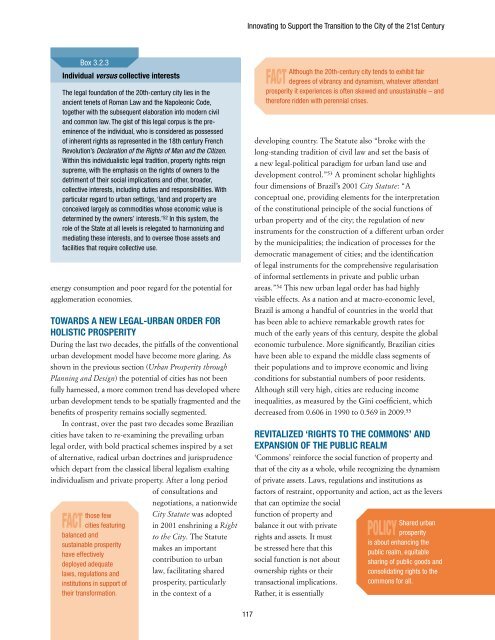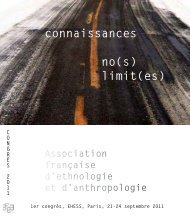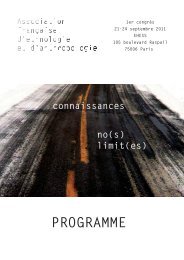state of the world's cities 2012/2013 - United Nations Sustainable ...
state of the world's cities 2012/2013 - United Nations Sustainable ...
state of the world's cities 2012/2013 - United Nations Sustainable ...
You also want an ePaper? Increase the reach of your titles
YUMPU automatically turns print PDFs into web optimized ePapers that Google loves.
Innovating to Support <strong>the</strong> Transition to <strong>the</strong> City <strong>of</strong> <strong>the</strong> 21st CenturyBox 3.2.3Individual versus collective interestsThe legal foundation <strong>of</strong> <strong>the</strong> 20th-century city lies in <strong>the</strong>ancient tenets <strong>of</strong> Roman Law and <strong>the</strong> Napoleonic Code,toge<strong>the</strong>r with <strong>the</strong> subsequent elaboration into modern civiland common law. The gist <strong>of</strong> this legal corpus is <strong>the</strong> preeminence<strong>of</strong> <strong>the</strong> individual, who is considered as possessed<strong>of</strong> inherent rights as represented in <strong>the</strong> 18th century FrenchRevolution’s Declaration <strong>of</strong> <strong>the</strong> Rights <strong>of</strong> Man and <strong>the</strong> Citizen.Within this individualistic legal tradition, property rights reignsupreme, with <strong>the</strong> emphasis on <strong>the</strong> rights <strong>of</strong> owners to <strong>the</strong>detriment <strong>of</strong> <strong>the</strong>ir social implications and o<strong>the</strong>r, broader,collective interests, including duties and responsibilities. Withparticular regard to urban settings, ‘land and property areconceived largely as commodities whose economic value isdetermined by <strong>the</strong> owners’ interests.’ 52 In this system, <strong>the</strong>role <strong>of</strong> <strong>the</strong> State at all levels is relegated to harmonizing andmediating <strong>the</strong>se interests, and to oversee those assets andfacilities that require collective use.energy consumption and poor regard for <strong>the</strong> potential foragglomeration economies.Towards a New Legal-Urban Order forHolistic ProsperityDuring <strong>the</strong> last two decades, <strong>the</strong> pitfalls <strong>of</strong> <strong>the</strong> conventionalurban development model have become more glaring. Asshown in <strong>the</strong> previous section (Urban Prosperity throughPlanning and Design) <strong>the</strong> potential <strong>of</strong> <strong>cities</strong> has not beenfully harnessed, a more common trend has developed whereurban development tends to be spatially fragmented and <strong>the</strong>benefits <strong>of</strong> prosperity remains socially segmented.In contrast, over <strong>the</strong> past two decades some Brazilian<strong>cities</strong> have taken to re-examining <strong>the</strong> prevailing urbanlegal order, with bold practical schemes inspired by a set<strong>of</strong> alternative, radical urban doctrines and jurisprudencewhich depart from <strong>the</strong> classical liberal legalism exaltingindividualism and private property. After a long period<strong>of</strong> consultations andnegotiations, a nationwidethose fewCity Statute was adoptedfact <strong>cities</strong> featuring in 2001 enshrining a Rightbalanced andto <strong>the</strong> City. The Statutesustainable prosperitymakes an importanthave effectivelycontribution to urbandeployed adequatelaws, regulations and law, facilitating sharedinstitutions in support <strong>of</strong> prosperity, particularly<strong>the</strong>ir transformation. in <strong>the</strong> context <strong>of</strong> afactAlthough <strong>the</strong> 20th-century city tends to exhibit fairdegrees <strong>of</strong> vibrancy and dynamism, whatever attendantprosperity it experiences is <strong>of</strong>ten skewed and unsustainable – and<strong>the</strong>refore ridden with perennial crises.developing country. The Statute also “broke with <strong>the</strong>long-standing tradition <strong>of</strong> civil law and set <strong>the</strong> basis <strong>of</strong>a new legal-political paradigm for urban land use anddevelopment control.” 53 A prominent scholar highlightsfour dimensions <strong>of</strong> Brazil’s 2001 City Statute: “Aconceptual one, providing elements for <strong>the</strong> interpretation<strong>of</strong> <strong>the</strong> constitutional principle <strong>of</strong> <strong>the</strong> social functions <strong>of</strong>urban property and <strong>of</strong> <strong>the</strong> city; <strong>the</strong> regulation <strong>of</strong> newinstruments for <strong>the</strong> construction <strong>of</strong> a different urban orderby <strong>the</strong> municipalities; <strong>the</strong> indication <strong>of</strong> processes for <strong>the</strong>democratic management <strong>of</strong> <strong>cities</strong>; and <strong>the</strong> identification<strong>of</strong> legal instruments for <strong>the</strong> comprehensive regularisation<strong>of</strong> informal settlements in private and public urbanareas.” 54 This new urban legal order has had highlyvisible effects. As a nation and at macro-economic level,Brazil is among a handful <strong>of</strong> countries in <strong>the</strong> world thathas been able to achieve remarkable growth rates formuch <strong>of</strong> <strong>the</strong> early years <strong>of</strong> this century, despite <strong>the</strong> globaleconomic turbulence. More significantly, Brazilian <strong>cities</strong>have been able to expand <strong>the</strong> middle class segments <strong>of</strong><strong>the</strong>ir populations and to improve economic and livingconditions for substantial numbers <strong>of</strong> poor residents.Although still very high, <strong>cities</strong> are reducing incomeinequalities, as measured by <strong>the</strong> Gini coefficient, whichdecreased from 0.606 in 1990 to 0.569 in 2009. 55Revitalized ‘Rights to <strong>the</strong> Commons’ andExpansion <strong>of</strong> <strong>the</strong> Public Realm‘Commons’ reinforce <strong>the</strong> social function <strong>of</strong> property andthat <strong>of</strong> <strong>the</strong> city as a whole, while recognizing <strong>the</strong> dynamism<strong>of</strong> private assets. Laws, regulations and institutions asfactors <strong>of</strong> restraint, opportunity and action, act as <strong>the</strong> leversthat can optimize <strong>the</strong> socialfunction <strong>of</strong> property andbalance it out with privateShared urbanpolicy prosperityrights and assets. It mustis about enhancing <strong>the</strong>be stressed here that thispublic realm, equitablesocial function is not about sharing <strong>of</strong> public goods andownership rights or <strong>the</strong>irconsolidating rights to <strong>the</strong>transactional implications. commons for all.Ra<strong>the</strong>r, it is essentially117





